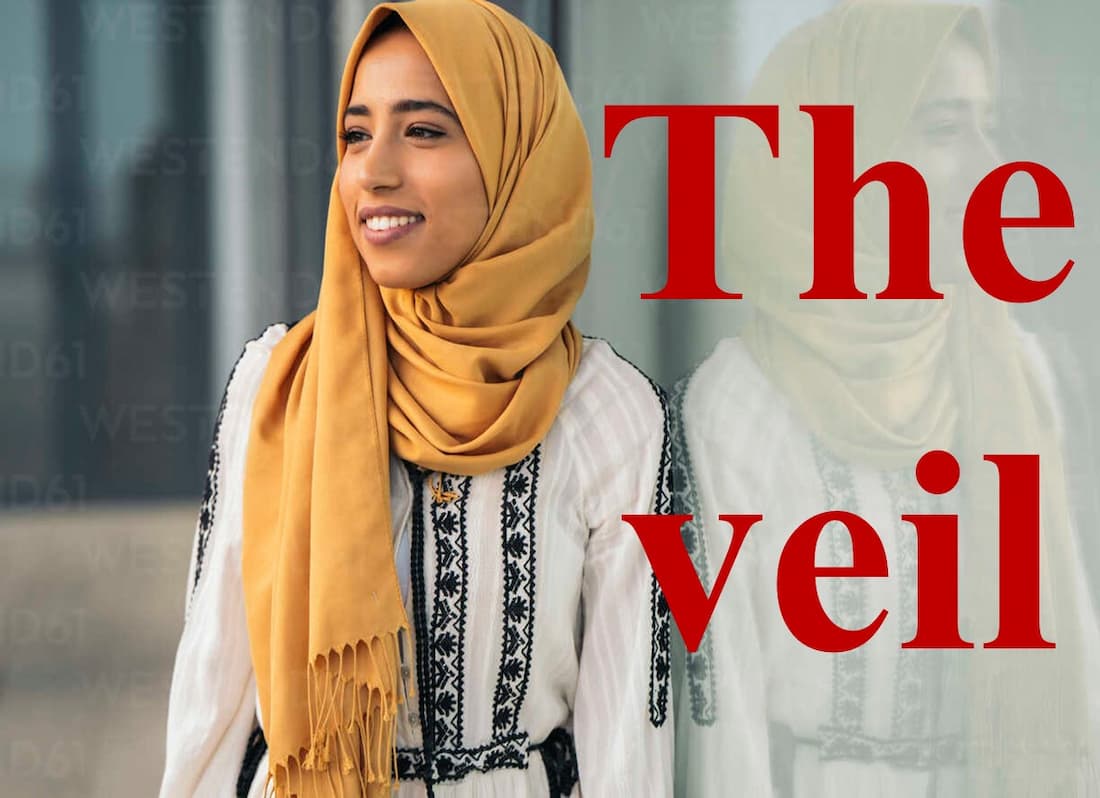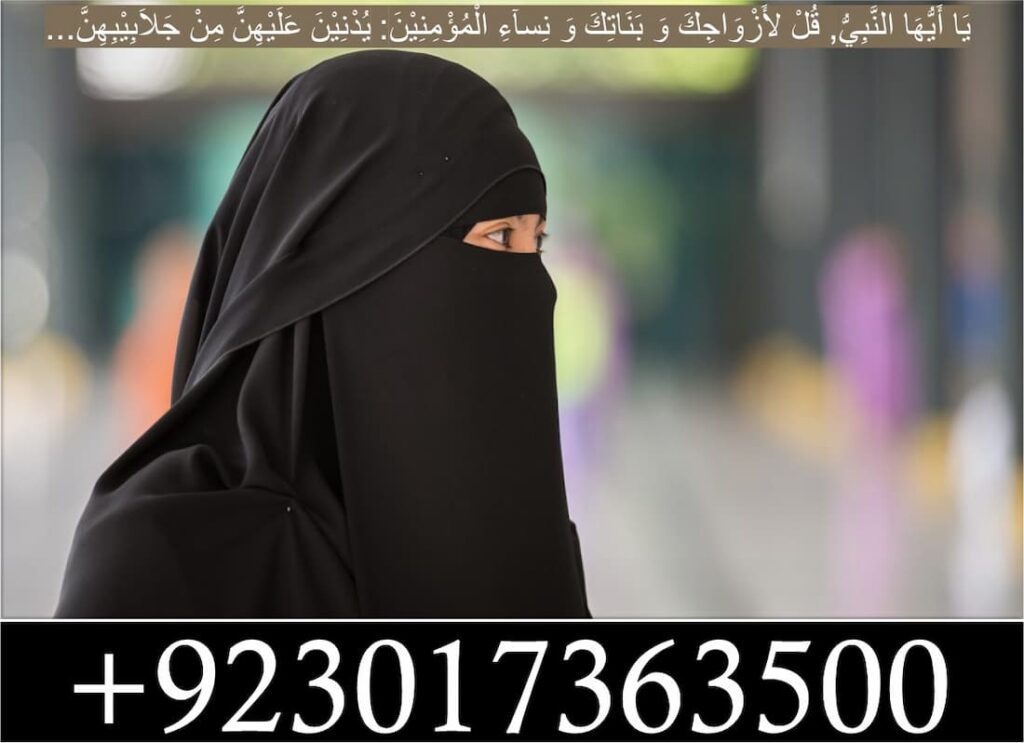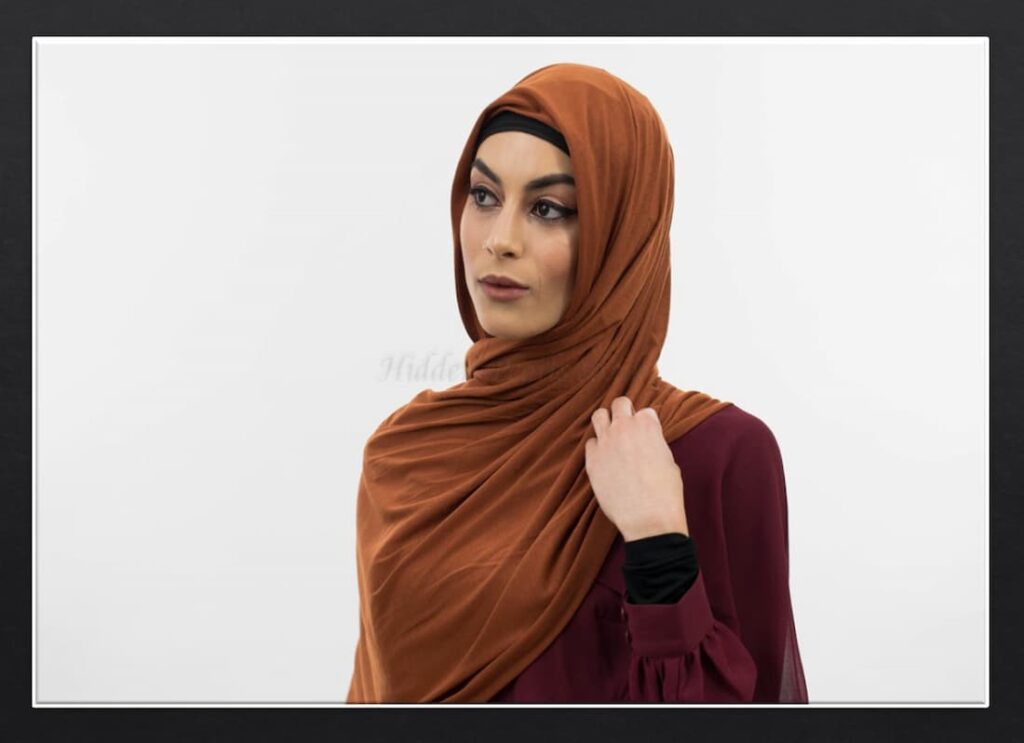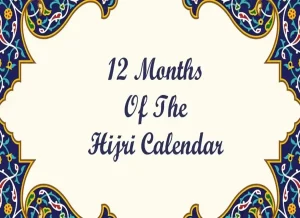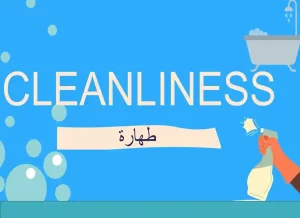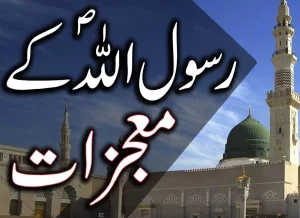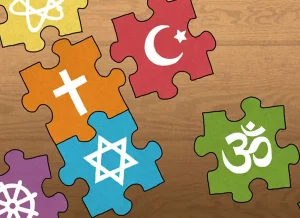Various forms of the veil for women in the past centuries of Islamic world – Dress Code | Women in Islam | Concept of The Veil in Islam
Ezar or Mezar: In early period of Islam, it has been used for different kinds of clothes… in the whole Islamic periods; this word has been used as meaning of big Chadors or covers by which eastern women wear them.( Dozy. Reinhart Pieter Ann(1879). THE STUDY OF ARAB CLOTHING: A BIBLIOGRAPHICAL EPILOGUE. Paris, Publisher: Maisonneuve. Vol 6. . p. 6.) (Mezar word has also gone to Italy and it is root of Mezarro i.e. a big piece of painted cloth by which women used to cover their heads and shoulders) (Ibid. P.45)
Jilbab: Bokhari used the word of Jilbab (which has been in Quran and at least is old since then) in the meaning of Ezar and said that is Chador which women (Women in Islam) wear their heads when they go out. (Jelbab or Jilbab is root of Jellebbai and Jillet. Ibid. p.118)
Hebrah: Is a kind of Burd, i.e. a striped loose dress which is making in Yemen. (in another part of this book is: a shirt or loose cover of black silk) Wearing Hebrah is common in Syria, Arabia and Algeria.
Kamari Chador (Belt Chador): Dress Code | Women in Islam | Concept of The Veil in Islam (A Chador which has a rope in it’s waist) there has not been used scissors cuts in its sewing, it is sewed from the inside the same as Aba which is fixing by a rope from head to waist or as a dickey around the waist and for wearing it, legs should be put into the middle and pulled up like pants and pull the upper part up to the head. Some ladies (Women in Islam) for more beauty, embroidered around it by lacing or sewing margins, this type of cover mostly was black color. Kamari Chador or Ghajari Chador is older model of Chador in Iran which used to be famous during the rule of Ghajarid.
Chador Namazi or Charkhi Chador: Dress Code-Women in Islam-(today Chador in Iran): Charkhi Chador or Round Chador the same as praying Chador is open- front and without belt. Ordinary women used to wear such striped blue and white Chadors which were made of cotton cloth (Chit and Canvas).
Borqa: Dress Code-Women in Islam | Concept of The Veil in Islam. A mask for women. Dozy quoted of John Fraser that Borqa in Mavaraa Al-nnahr was a kind of cover which has been worn from the heads to feet of the women. In Afghanistan, people have named their cover Borqa. (Ibid, P. 63)
Khemar:Dress Code-Women in Islam | Concept of The Veil in Islam. (That is mentioned in the Quran and had been used as scarf in that time) It is a type of Hijab for women which covers front of neck, chin and mouth and connect to each others in head.
Chaarie (or Shaariah):Dress Code-The Veil- Thin cloth of black horsehair that women cover their faces by them and could see their ways through the gap of them. (Ibid, P. 215)
Shawl:Dress Code-Women in Islam | Concept of The Veil in Islam. A piece of a long hairy or wool cloth that they wrinkle it and wrap it around the neck several times. It is a Persian word which has been gone into many European countries.
Maghnaah(Ghenaa, Maghnaa): a piece of cloth (Kerchief or Charghad) that both men and women fasten to their heads. (Ibid, P.353) (Zoroastrians consider that the same as Makna which is a cover of Zoroastrian women).
Yashmagh,Dress Code-The Veil- Women in Islam-(or Yashmak): a black cotton or silky cloth which hangs from the forehead by a decorative object, gold or silver or bronze. Would connect and hangs. This curtain wear whole of face except eyes, covers sometimes on chest and sometimes it comes on knees.
Neghab- Dress Code-The Veil- (which is called Ruband in Iran) or Mask: Women in Islam | Concept of The Veil in Islam. Nighāb A Curtain with holes. That is a cloth which there are two holes and in white slim and tall in front of the eyes. (According to the verb Naghaba to mean Fiddler thrust) (Ibid, P.353)
Ruband or Ruband: Ruband traditionally scavenger was worn by Iranian women in the 9th century, when Ibn Battuta (a Persian traveler in the 9th AH, 16AD) met Shiraz. Articles Iranica, 1385, 154)
Djenné; The piece of cloth which is used to cover head except to face and two sides of the chest and have been made two holes in eyes places so that it looks like Borqa. (Ibid, P. 398-399 Ibid, P. 120)
Chashm Aviz (literally hanging net in front of eyes): It is a Black net mask of horsehair that women wear as an amulet. This cover allowed women to cover their eyes concurrent with hide from others, be able to see. This mask used to be wear from medieval. This type of cover has been named Ayazy or Ayasy as well.شهبازي، ع.شاپور)1383(، پوشاک در ايران زمين ،از سري مقالات دانشنامه ايرانيکا، انتشارات اميرکبير، تهران ،ص 373)
Picheh:Women in Islam | Concept of The Veil in Islam. It is a mask which is made of a weaved horsehair or by a rope which fasten to the forehead and through it to the front of their faces. The length and width, tiny and the texture of the coarseness of the elderly and the youth people was less. (Gheibi. Mehr Asa (1385AH, 1995AD) Eight Millennium Apparel of People in Iran.Tehran. Published by Hirmand. AH. P.345)
Chaghchur: It is a sock or socks drawers which are made of two connected parts from ankles up to the waist. (Ibid. P. 345 Ibid.)
Types of caps: There are many varieties of hats in aftermath of Islam. Hat usually includes half circle hats with beautiful decorations.(Ibid. P. 345 Ibid.) Domination of Mongols in Iran, was coincident with entrance of many styles, special in Far East, particularly, Chinese styles to Iran.
In this period, Dress Code | Women in Islam | Concept of The Veil in Islam.women’s clothes did not change a lot, unless their head’s covers which were similar to kerchief for non Mongol women.
Women’s Hijabs in different Islamic countries
Firstly, I deal with considering variety of women’s Hijabs in Islamic lands (Women in Islam-Concept of The Veil in Islam). Our resources regarding to this issue are: clothes history books and thesaurus of dresses and logbooks. Dozy has investigated about different kinds of coverage of women in Islamic countries by using travelogue of explorers. First, it explains the diversity of shapes and designs of clothing and colors in large cities but in all their elements are simple .He mentions the origin of the dress simplicity of Muslims social culture as follows:
Prophet Muhammad (SAW) has repeatedly said in his advises that luxury should not get into his nation: Ornaments, if are for Showing grace and goodness that God has given us, are not unlawful but if they are only of pride and showing off is not allowed. Simplicity in dressing has been often recommended on behalf of Arab and Iranian leaders to males. (Ibid, 7) He writes about color of outer clothes of Muslims as follows: “The colors have been used frequently in Islam’s period are white and black.”
He attributes the black dress of condolence to Abbasid Caliphate. (First, it explains the diversity of shapes and designs of clothing and colors in large cities but in all their elements are simply)
In the Umayyad Caliphate governance in Spain, condolence dresses of Muslims were white. ( Ibid, 20)He has quoted from some Arab writers that Sadat clothes were green color.
Egypt: There have been mentioned in the logbook of Helfrish that:
In the city of Cairo, whole women wear the same clothes i.e. when they go outside of homes, they used to cover themselves in a white and nice Chador, called Ezar. (Ibid, 20) Corneille Dobrin says about Arab women in Cairo: when they go out of their homes, they cover their entire bodies as well as their heads except their eyes. This is similar to the Spanish covers. This author continues that, they wear Borqa which is made of a black and atlas cloth and those who are from the generation of Mohammad prophet (SAW) have green Borqa.
“In large cities, women follow the way they have learned from Turks i.e. they hang on a small curtain which is weaved of horsehairs…. Using Shaariah in this city has been expanded from the period of Soltan Salim.”
Jerusalem: Dazi mentiond from the Mentegza: out of houses, women cover themselves by a white cover which is weaved of cotton and thin cloth. They bring the cloth from India and called weaved and women wear them as this. In Reje travelogue is mentioned that: women cover themselves by thin clothes of horsehairs and this cover is called Shaariah by which women could see and walk.
Dozy has quoted of Helfrish that, women in Jerusalem, used to cover themselves by white cloth instead of wearing outer clothes how, their whole bodies were covered as well as their clothes and differentiating them was impossible as was common in Cario. Wearing Hebre in Saudi Arabia, Syria and Algeria is common. Borghart says: Mecca’s women wear loose shirts made of black silk, as was common in Egypt.
Iran: Tavarnihe writes:
“Women in Iran don’t show themselves to anyone except their husbands. When they go to public bathrooms, they used to wear themselves by white Chadors by which they cover their entire bodies.”
The outdoors clothes are including a long white Chador which covers the whole bodies that are white or black masks weaved of horsehairs, they have either modesty or anonymity. Outdoor clothes of women that used to be masks or white Chadors along with loose trousers or without trousers, have been changed to black or dark Chadors at the middle of the last century. Of course, women’s Hijabs which have been Black Chadors in recent centuries and in these recent decades, Manto (a loose and long shirt which is shortened lately) and scarf or Maghnae have been placed instead of it.
India: Indian women often wear their traditional, beautiful and colorful clothes, Sari. Sari is mostly made of silk and made of many parts including: one blouse, a long skirt and one long shawl. There are many models of this clothe in India. Of course, in addition to Sari, women wear another type of clothe in India called Panjabi. It is mostly common between Muslim Indians and covers bodies more than Sari does. The difference of Panjabi and Sari is in having trousers. Panjabi is making of a long dress and loose trouser, conversely, Sari is made of a long dress and a short blouse which can be complemented by a long shawl.
Algeria: Algerian women typically have got Islamic veils. Today, there are three kinds of Hijab in Algeria including: traditional Hijab ( Al-Hayek) which is made of a white Chador with a white Nighab, and is common among Algerian women. Al-Malaye, which is another type of traditional Hijab, is made of a black Chador like an Aba, is common in eastern cities of Algeria. Al-Jebab, that occasionally, is like a black or dark blue Chador along with a Nighab which covers the whole faces except eyes and sometimes used as Chador the same as Hijab of Iranian and Lobnanian women.
Malaysia: There are variety of models and colors in Muslim Malaysian’s women veils. Common clothe in this country is Baju Kurung that is loose and long dress. Occasionally, the women are interested in wearing Baju Kebaya, which is a tight blouse, instead of Baju kurung. Kebaya is a short shirt along with skirt that can be considered as Muslim Malaysian traditional dresses.
Indonesia: In Indonesia, the word which is more common for Hijab is Jilbab and its regarding to head coverage. Hijab has become popular in year 1980 in Indonesia. In recent centuries, western Colonialists with internal Tyrant mercenaries have culturally changed Islamic countries.
Contriving for political domination by cultural penetration, economic colonialism by issuing culture of modernism and consumerism caused essential changes in Muslim women’s traditional coverage and by growth of feminism phenomenon Islam’s world has confronted similarity between men’s and women’s clothes and also bareness phenomenon which reduce the femininity dignity of women and their own particular Hijab.
Islam has demonstrated the destructive consequences of these phenomena and commanded to avoid them. Although those Muslim women who believe Hijab may wear western clothes in parties or their homes in recent centuries, when they go to public, wear traditional or new Hijabs.
Conclusion
Regarding to the importance of Hijab in Islam, observing public modesty among Muslim nations and Hijab has been always considered by Islamic leaders. According to historical evidences, during the period of cultural history of Islam world, with a little bit ups and downs, there are wonderful variety of shapes and colors of Hijabs in different countries. But general trend is to observing the Hijab’s borders.
Of course, in some cases in addition to hair cover, covering faces have become common which seldom can be seen in a few Islamic countries. Islamic world are influenced by western cultural changes and contrived by colonialists in economic and political aims and need more attention for maintaining traditional and cultural values based on modesty and Hijab.
More information :Encyclopaedia of Islam English, Names of Allah, Arabic 101, Islamic Prayer Rug, Muslim Prayer Rug, Muslim Abaya, The Verse of Hijab, Muslim Abaya, Buy 3 PCS Women Long Scarf, Soft Scarf, Scarf Online, Some Aspects of Islamic Culture by S. M. Yusuf and Write commandments about modesty and honor in islam?
https://youtu.be/NrUp1AnSM9Y
Praise be to Allah I, we thank Him, seek His Help and His Forgiveness. We seek refuge in Allah I from the evils of ourselves and that of our bad deeds. He whom Allah I guides, is truly guided, and he whom Allah I leaves to stray, none can guide
him. I bear witness that there is no god but Allah I, who has no partner and I bear witness that Muhammad r is His Messenger.

